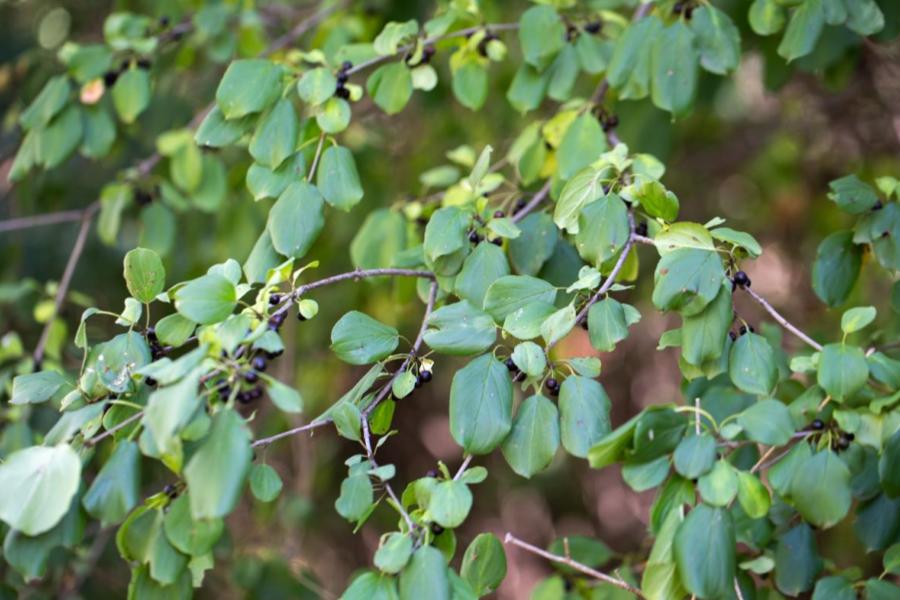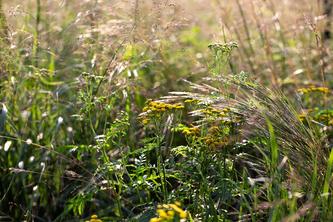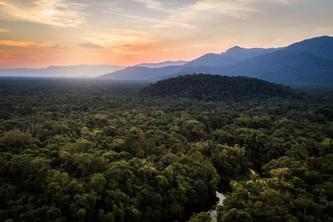
MINNEAPOLIS/ST. PAUL (10/11/2022) — Late fall is often an ideal time to remove invasive buckthorn species, which have spread widely across Minnesota. Buckthorn outcompetes native plants, suppresses the growth of canopy tree seedlings and reduces habitat quality for wildlife.
Researchers at the Minnesota Invasive Terrestrial Plants and Pests Center (MITPPC) have spent years pursuing effective, efficient and accessible management tactics for buckthorn. The Environment and Natural Resources Trust Fund has invested in MITPPC as recommended by the Legislative-Citizen Commission on Minnesota Resources to ensure researchers are studying some of the worst invasive species, like buckthorn, and developing solutions to protect Minnesota’s lands and wildlife.
Mike Schuster, a researcher with MITPPC and the College of Food, Agricultural and Natural Resource Sciences, answers questions about how you can manage the invasive species this fall.
Q: What is invasive buckthorn?
Schuster: There are two types of invasive buckthorn in Minnesota: common buckthorn and glossy buckthorn. Both species were introduced to Minnesota as ornamental plants and have now spread widely across the state. Both buckthorn types have brown bark with silvery marks, leaves that stay green late into fall, and very pronounced veining on their leaves that help distinguish them from similar plants. Common buckthorn grows up to 20 feet tall, has oval shaped leaves, small five-petaled flowers that are greenish-white, and round berries that transition from green to dark purple when ripened in August and September. In contrast, glossy buckthorn can grow up to 30 feet tall, has leaves that are distinctly egg-shaped and pointed at the tip, small four-petaled flowers that are yellow-green, and sparsely clustered round berries that are black and shiny when they ripen.
Q: Why is buckthorn a problem?
Schuster: Buckthorn pushes out native plants important for erosion control and wildlife. It also has been linked to another major invasive species in recent years, soybean aphids. Soybean aphids are currently the number one insect threat to Minnesota soybean growers, and the insects lay their eggs on buckthorn for the winter. Buckthorn can also host the fungus responsible for oat crown rust. Removing buckthorn is an ongoing process that requires dynamic, simultaneous strategies because of how voracious the plant is. Cut buckthorn can resprout vigorously and repeatedly, and buckthorn seeds left in the soil can continue germinating. Even after the seedbank is exhausted, birds often continue to bring buckthorn seeds into the area.
Q: How can I remove buckthorn?
Schuster: A small infestation can often be pulled by hand or with a weed wrench tool. If your buckthorn infestation is large, a more efficient option may be to chemically treat it with foliar herbicides. Goat-grazing is a newer method for invasive plant control and could be useful for accessing hard-to-reach areas. However, more research is needed to better understand this strategy. It’s also important to note that different herbicides can have varying effects on goats. So, if you plan to use goats in conjunction with herbicides, make sure to follow the grazing restrictions associated with the specific product you use. If you prefer not to use herbicides, non-chemical options like wrapping stumps in black plastic can be used to prevent re-sprouting.
Q: What can I do to make sure the buckthorn doesn’t come back?
Schuster: Studies show that re-establishing dense native plant cover immediately after removing buckthorn causes the native plants to outcompete buckthorn for light availability, which helps suppress reinvasion. MITPPC researchers have seen that planting native grasses, wildflowers, sedges and ferns can cut the amount of returning buckthorn in half over a few years. Scientists have also seen the greatest reduction in buckthorn reinvasion with planting trees or shrubs, which can reduce the amount of returning buckthorn by up to 90%. In addition to helping keep buckthorn at bay, this method can improve and diversify the native plant community, reduce herbicide use and result in significant cost and labor savings for large-scale property managers and individual homeowners alike. However, this method isn't a stand-alone tool against already-present buckthorn plants that are re-sprouting from cut or damaged stems. Those stems grow too quickly to be out-competed by the new plants and need to be managed through other means. MITPPC has developed a comprehensive guide for managing invasive buckthorn with additional information.
Q: What are MITPPC researchers currently working on?
Schuster: Through our research initiative “Cover it Up!,” we are investigating how re-establishing native plants can control buckthorn following removal efforts. Through our previous experiments, we determined that buckthorn has a limited shade tolerance and won’t thrive when specific woody species are present and produce a high level of shade. We still need to learn more about if, when and where seed mixtures can result in these critical levels of shading. To better understand the potential value of seeding across the diverse environments of the state, we are working with citizen scientists across Minnesota who established their own experimental sites. These participants removed buckthorn from areas of their property, seeded the area with a mix of native grasses, sedges, wildflowers, shrubs and trees, and reported their findings to the University of Minnesota. The University is currently collecting data from summer 2022 participants and we expect to report findings from this study soon. We encourage anyone interested in following along with the latest findings or learning more about ways to participate to sign up for our email newsletter at coveritup.umn.edu.
Mike Schuster is a researcher in CFANS and MITPPC. His current research focuses on novel control methods of common buckthorn (Rhamnus cathartica) as part of the Minnesota Invasive Terrestrial Plants and Pests Center. His other areas of interest include forest and grassland ecology, decomposition, climate change and invasive plant species.
-30-
About the College of Food, Agricultural and Natural Resource Sciences
The University of Minnesota’s College of Food, Agricultural and Natural Resource Sciences (CFANS) strives to inspire minds, nourish people, and sustainably enhance the natural environment. CFANS has a legacy of innovation, bringing discoveries to life through science and educating the next generation of leaders. Every day, students, faculty, and researchers use science to address the grand challenges of the world today and in the future. CFANS offers an unparalleled expanse of experiential learning opportunities for students and the community, with 12 academic departments, 10 research and outreach centers across the state, the Minnesota Landscape Arboretum, the Bell Museum of Natural History, and dozens of interdisciplinary centers.
About the Minnesota Invasive Terrestrial Plants and Pests Center
The Minnesota Invasive Terrestrial Plants and Pests Center (MITPPC) was founded by the Minnesota Legislature to research the prevention, detection and control of terrestrial invasive species. MITPPC researchers use transformative science to prevent and minimize the threats posed by land-based invasive plants, pathogens, and pests. Founded in 2015, MITPPC is the only research center of its kind in the country, and the center's work to protect the state's native prairies, forests, wetlands, and agricultural resources benefits all of Minnesota and beyond. Learn more at mitppc.umn.edu.
- Categories:
- Agriculture and Environment
- Landscapes





